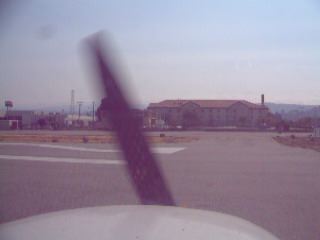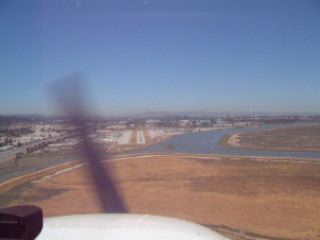Wassup fresh? It's our turn baby. Hola all you el gato negros. Some people may think that flying is an interesting tidbit, like Michael Jackson in A-B-C, 1-2-3. So I have went ahead and took some pictures and will explain the basics of flying a small aircraft. Is this OK? Well, let's get our roll on. By the way, if anyone can manage to have an entire conversation with me using only song lyrics and/or song titles, I will be duly impressed. Pictures come courtesy of me, Peter and Daryl.
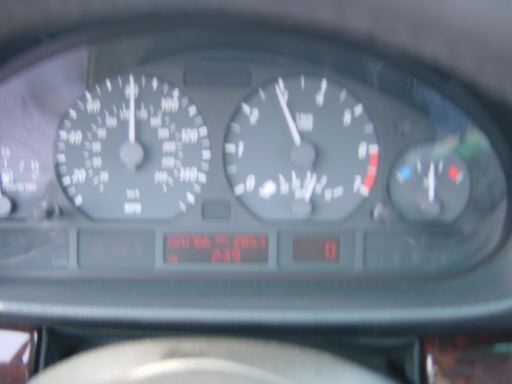
Well first of all, we have to get to the airport in our cars. So make sure you are doing at least 80 on the 101N. Today I was doing 'bout 85 and a highway patrolman came all ninja style and sneaked up behind me and turned on his sirens/lights. I was like oh damn. But as soon as I switched lanes to pull over he flew past me. Nice. Has someone ever floored it when a cop flicks on the lights? Doing at least a hun-doh and then busting a controlled drift all the way around those clover-leaf on/off ramps? Fear and loathing style my friends.
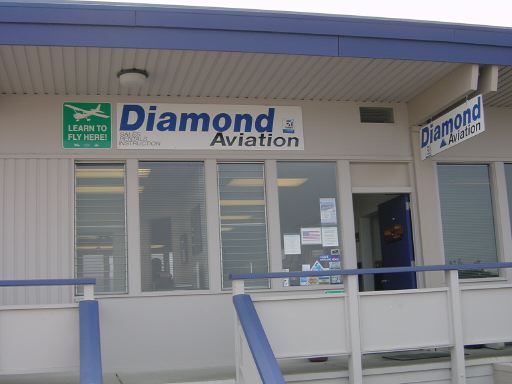
This is my flight school, Diamond Aviation.

Before we fly, we should check the weather and other things, such as flight restrictions and such around buildings like Stanford Stadium. We can do this many ways. We can call 1-800-WXBRIEF or use the Entirenet to get DUATS.
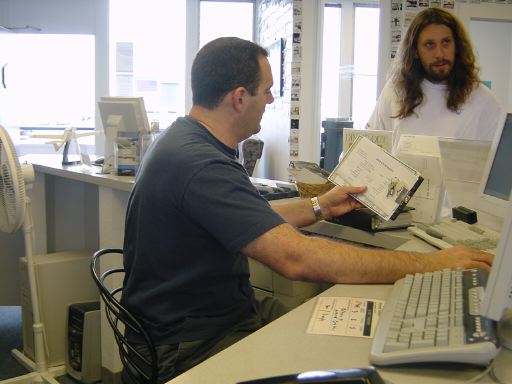
We then get a dispatch, which is a piece of paper with the Hobbs time (basically time flown), the tach time and our name. Also the keys to the aircraft. This gentleman at the desk is the Mr. Steve.

We check the time board to make sure we are not going over any times. Flight schools have to have 100 hour inspections (using the Hobbs time) every 100 hours. But our school takes it one step further doing 50 hour inspections. To make sure we are not going to go over these times, we check the dispatch sheet's Hobbs time vs. the times on the board. But usually the guys at the desk automatically block out aircraft that are due in 6 hours or so. So it doesn't really matter.

The squawk sheet is a clipboard of papers (one for each aircraft) that lists complaints and things broken on every aircraft, such as an inoperative autopilot or transponder intermittent. If there is anything seriously wrong, then obviously the aircraft would not be flying.

This is me in front of our plane that we will be flying. It is Cessna N174ME, a 2000 Cessna Skyhawk 172SP.
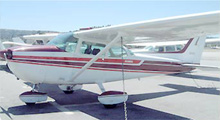
This is the plane I usually flew when training, a 1980 Cessna Skyhawk. I liked this plane because nobody ever rented it. Guess why. Because nothing worked in it besides one radio. Ghetto.

That is the interior for that bitch.
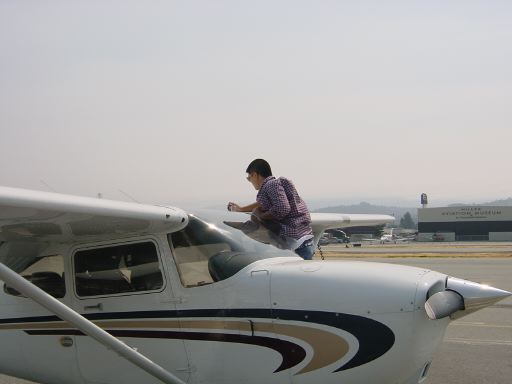
Preflight. Before every flight we need to check certain items, such as the lights, if we have gas, if we have gas contamination, if our ailerons, rudder, flaps and elevator works, if the fuselage is clear of any dents or other defects, if the prop is relatively smooth, and so on. And now, Airplane Basics 101.

That thing on the wing that is up right now is called an aileron. There is one on each wing. It controls our roll, movement around the longitudinal axis. Imagine lying down on top of a hill and rolling down it. That would be the type of movement we see here. When moving the yoke to the left, the left aileron comes up, the right aileron goes down, the left wing goes down and the right wing goes up, banking us the the left.

Opposite for the right. Move the yoke to the right, and the right aileron goes up, the left aileron goes down.

One might wonder what purpose the rudder serves since the ailerons turn us. When turning the plane to the left, the downward deflected aileron on the right produces more lift and more drag. Imagine sticking your hand out a car window. You are creating more drag with your hand, pushing it back. This drag wants to pull the nose in the direction of the raised wing (right) so the rudder just kicks the ass of the plane in the right spot. This is called adverse yaw. Left rudder pedal makes the rudder go left, controlling our yaw, movement around the vertical axis. It is the movement that cars make.
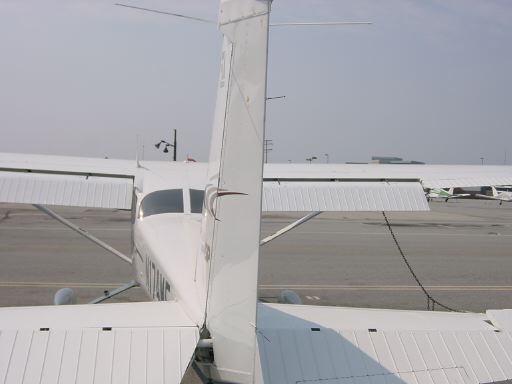
And right rudder pedal pushes the rudder to the right.
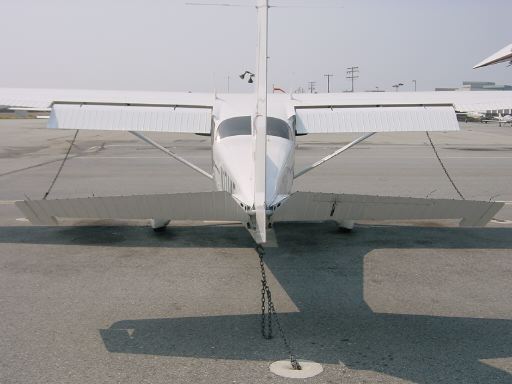
The things down on the wings are called flaps. They let us steepen our angle without increasing our airspeed. We usually use them for landing. Sometimes for takeoff, and slow flight. The thing up on the tail now is the elevator. This controls our pitch, movement around the lateral axis. Basically our up/down movement. Pull back on the yoke, the elevator goes up, and we start to climb.

Push forward on the yoke, the elevator goes down, and we descend.
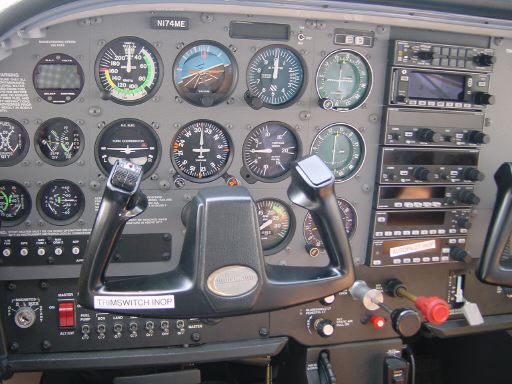
This the interior. This is what the big dials are- from top to bottom, left to right. Airspeed indicator, attitude indicator (what the horizon should look like outside), altimeter, VOR (used for navigation), turn coordinator (tells us how much rudder to use and also how much bank we have, up to standard rate of turn), heading indicator (kinda like a compass, but you have to set it manually and check it every 15 min. or so against a compass to make sure it's still right), vertical speed indicator (how fast of a descent/ascent we're doing), another VOR, tach, and ADF (another type of navigation- it basically points to where a radio station is). This plane is nice, with GPS and two radios. I'm not used to such comfort.
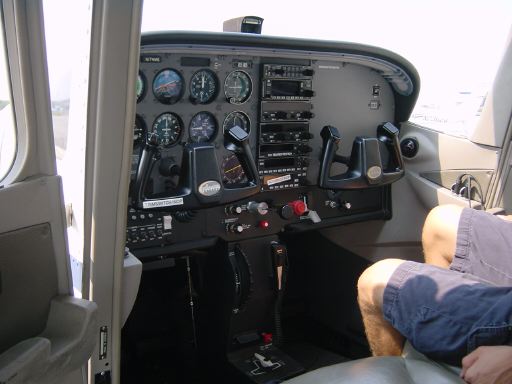
Another shot of the interior.

These are the rudder pedals. The tops are to control braking. And again, each pedal controls each brake. We can use these to stop and to do tight, tight turns (on the ground). And that little wheel on the right is sort of a ghetto autopilot. It is called trim, and keeps us from moving up/down.

Now... the preflight is done, everything looks good, the chains are off, we are in, the engine is started. ATIS time. ATIS tells us many things like the wind, visibility, the ceiling, and NOTAMS (notices to airmen). Of course, be rocking the Bose Aviation X headset.

Our ground radio call. This allows us to move from parking to the runway. Everything I say will be in green, and everything the tower/ground says will be in purple. Hola ground, this is Cessna 1-7-4-mike-echo at Diamond. Taxi to active runway with information bravo. Cessna 4-mike-echo, taxi to 1-2 via juliet-2. 1-2 via juliet-2, 4-mike-echo.

Run-up. This lets us test our engine among other things.

After making the tower call, we are cleared for takeoff.
A video of us doing a soft-field takeoff. This simulates a dirt or grass runway where our front wheel cannot dig in, so we basically wheelie on our mains down the runway, fly in ground effect until we reach best rate of climb speed, and then pull up. And yes, I realize I am off the centerline. Click on the picture to download the vid. (5.2MB)
This is a video of us doing a power-off stall. This simulates a plane stalling when landing. The traffic pattern is where most spins occur. (4.3MB)
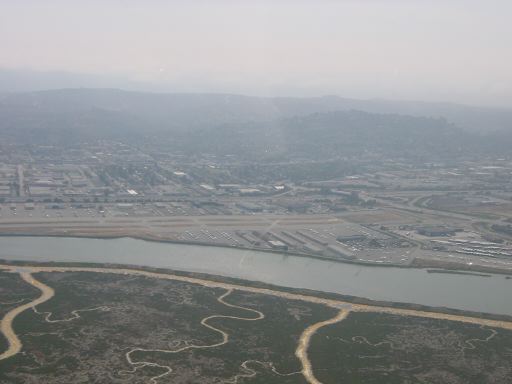
At airports we fly a traffic pattern, which is basically a rectangle using the runway as one of the long sides. This is called the downwind leg. To be more specific, the left downwind leg.

Yeah it was very windy today. This windsock doesn't show it, but ATIS was calling for a 16 knot direct crosswind.

Look Ma, no hands. Since we use the rudder/brakes to turn on the ground, we don't need to have our hands on the yoke. Actually we do, since we had a big crosswind and that is safe procedure. And one should always have a hand on the throttle. Oh I'm such a bad person.

This is a neat picture that Peter took of the Golden Gate bridge.
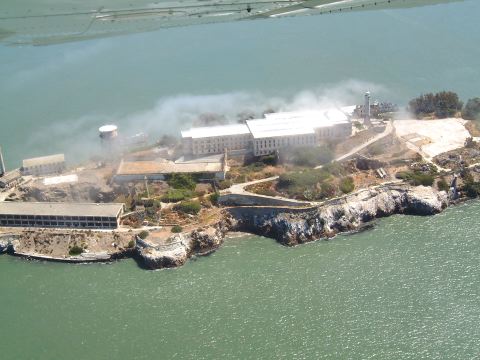
This is us buzzing Alcatraz, The Rock, at around 600 feet.
This is a video of us flying near SFO. (5.3MB)
This is called a go-around video. I was coming in way too fast, about 80 knots, when one should be coming in around 65-70 knots, and I couldn't land it. I need to get back into the game. (7.4MB)
This is a video of a normal landing. (6.4MB)
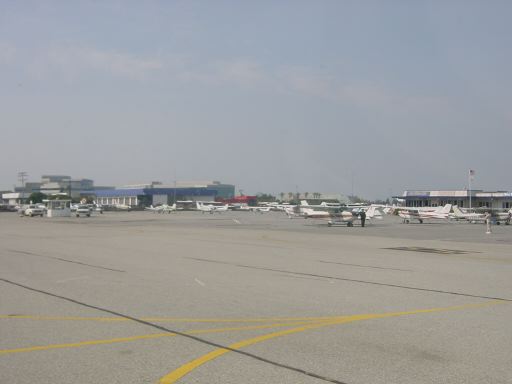
Well let's look for a parking spot.
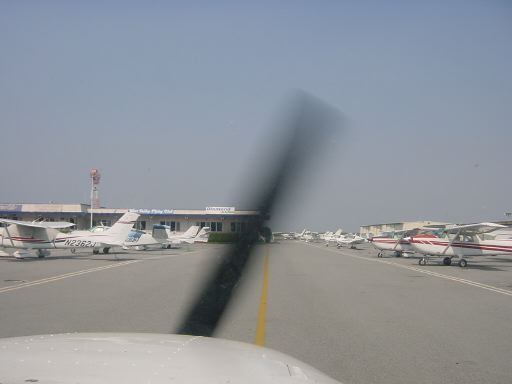
This is the scariest part for me, because I once dinged a plane taxiing. Ugh. The nice thing about that is when you're with your instructor, it's always his/her fault.
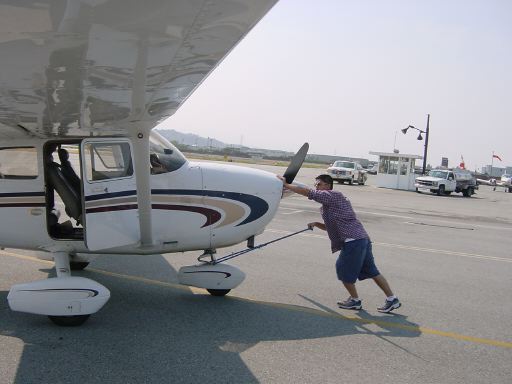
And we have to push the plane back into its spot.
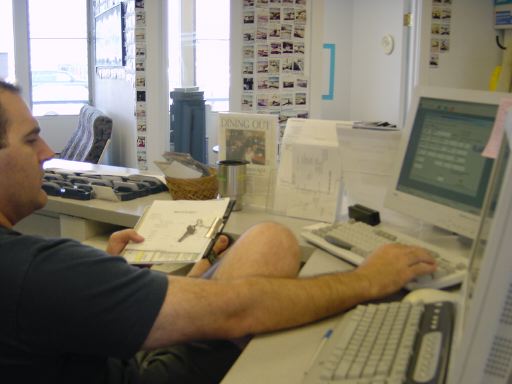
Payment. I hate this part too. It costs too much monies.

This is the wall of fame. Whenever someone does a first solo or gets a rating, a picture is taken. Hopefully I'll have about 7 pictures on there when I'm done.
And goodbye. If anyone wants to go fly somewhere, give me a ring a ling ding.
